Barriers for Antimicrobial Stewardship Among Junior Doctors
VerifiedAdded on 2023/06/04
|15
|4032
|351
AI Summary
This paper evaluates the barriers to effective implementation of the AMS strategies among the junior doctors. Antibiotics are among the most common antimicrobial prescribed medicines. However, there is an alarming increase of bacterial resistance amidst the plethoric availability of antimicrobial agents. The arising antimicrobial resistance (AMR) has gained global attention for common bacterial infections such as Staphylococcus aureus that was once treatable are now incurable. Read more on Desklib.
Contribute Materials
Your contribution can guide someone’s learning journey. Share your
documents today.
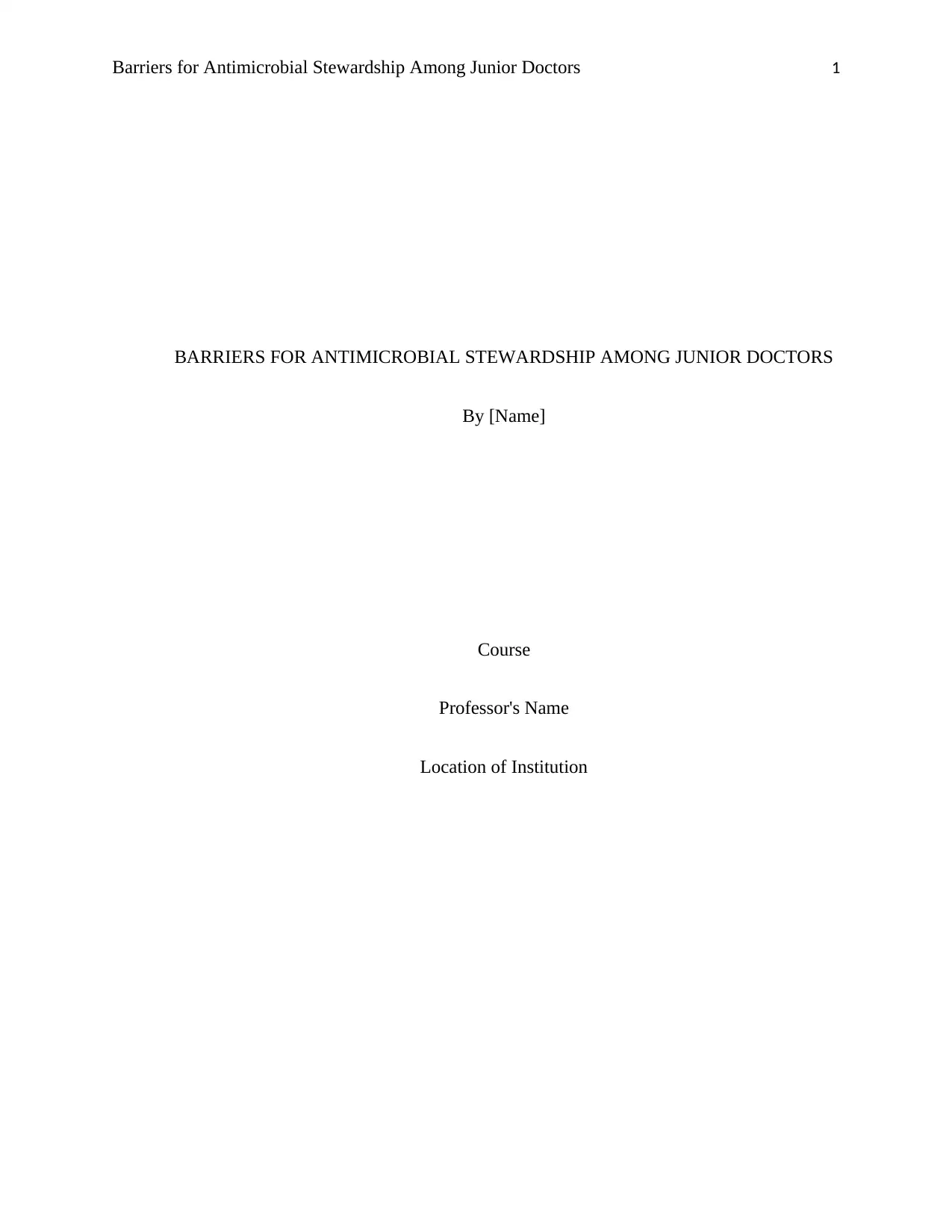
Barriers for Antimicrobial Stewardship Among Junior Doctors 1
BARRIERS FOR ANTIMICROBIAL STEWARDSHIP AMONG JUNIOR DOCTORS
By [Name]
Course
Professor's Name
Location of Institution
BARRIERS FOR ANTIMICROBIAL STEWARDSHIP AMONG JUNIOR DOCTORS
By [Name]
Course
Professor's Name
Location of Institution
Secure Best Marks with AI Grader
Need help grading? Try our AI Grader for instant feedback on your assignments.
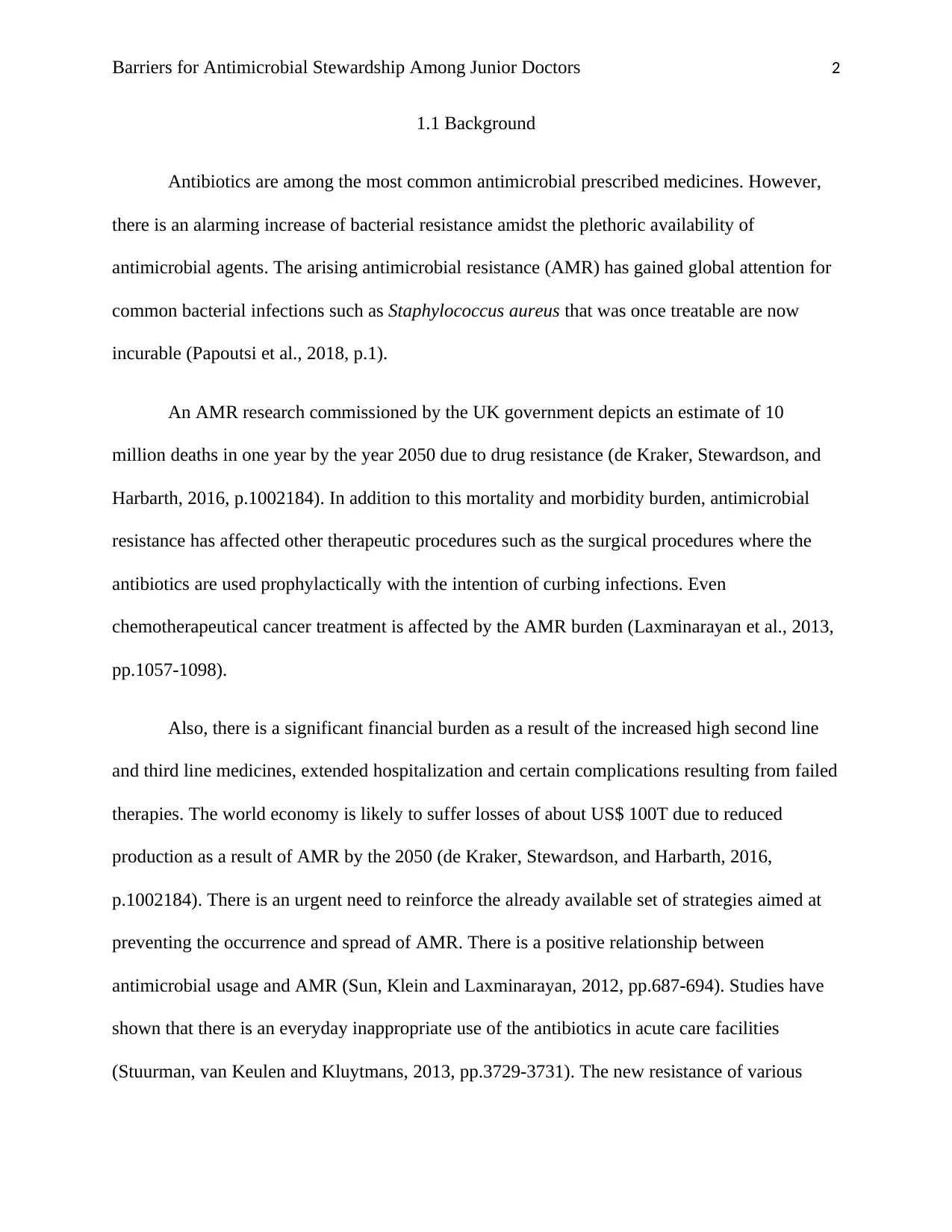
Barriers for Antimicrobial Stewardship Among Junior Doctors 2
1.1 Background
Antibiotics are among the most common antimicrobial prescribed medicines. However,
there is an alarming increase of bacterial resistance amidst the plethoric availability of
antimicrobial agents. The arising antimicrobial resistance (AMR) has gained global attention for
common bacterial infections such as Staphylococcus aureus that was once treatable are now
incurable (Papoutsi et al., 2018, p.1).
An AMR research commissioned by the UK government depicts an estimate of 10
million deaths in one year by the year 2050 due to drug resistance (de Kraker, Stewardson, and
Harbarth, 2016, p.1002184). In addition to this mortality and morbidity burden, antimicrobial
resistance has affected other therapeutic procedures such as the surgical procedures where the
antibiotics are used prophylactically with the intention of curbing infections. Even
chemotherapeutical cancer treatment is affected by the AMR burden (Laxminarayan et al., 2013,
pp.1057-1098).
Also, there is a significant financial burden as a result of the increased high second line
and third line medicines, extended hospitalization and certain complications resulting from failed
therapies. The world economy is likely to suffer losses of about US$ 100T due to reduced
production as a result of AMR by the 2050 (de Kraker, Stewardson, and Harbarth, 2016,
p.1002184). There is an urgent need to reinforce the already available set of strategies aimed at
preventing the occurrence and spread of AMR. There is a positive relationship between
antimicrobial usage and AMR (Sun, Klein and Laxminarayan, 2012, pp.687-694). Studies have
shown that there is an everyday inappropriate use of the antibiotics in acute care facilities
(Stuurman, van Keulen and Kluytmans, 2013, pp.3729-3731). The new resistance of various
1.1 Background
Antibiotics are among the most common antimicrobial prescribed medicines. However,
there is an alarming increase of bacterial resistance amidst the plethoric availability of
antimicrobial agents. The arising antimicrobial resistance (AMR) has gained global attention for
common bacterial infections such as Staphylococcus aureus that was once treatable are now
incurable (Papoutsi et al., 2018, p.1).
An AMR research commissioned by the UK government depicts an estimate of 10
million deaths in one year by the year 2050 due to drug resistance (de Kraker, Stewardson, and
Harbarth, 2016, p.1002184). In addition to this mortality and morbidity burden, antimicrobial
resistance has affected other therapeutic procedures such as the surgical procedures where the
antibiotics are used prophylactically with the intention of curbing infections. Even
chemotherapeutical cancer treatment is affected by the AMR burden (Laxminarayan et al., 2013,
pp.1057-1098).
Also, there is a significant financial burden as a result of the increased high second line
and third line medicines, extended hospitalization and certain complications resulting from failed
therapies. The world economy is likely to suffer losses of about US$ 100T due to reduced
production as a result of AMR by the 2050 (de Kraker, Stewardson, and Harbarth, 2016,
p.1002184). There is an urgent need to reinforce the already available set of strategies aimed at
preventing the occurrence and spread of AMR. There is a positive relationship between
antimicrobial usage and AMR (Sun, Klein and Laxminarayan, 2012, pp.687-694). Studies have
shown that there is an everyday inappropriate use of the antibiotics in acute care facilities
(Stuurman, van Keulen and Kluytmans, 2013, pp.3729-3731). The new resistance of various
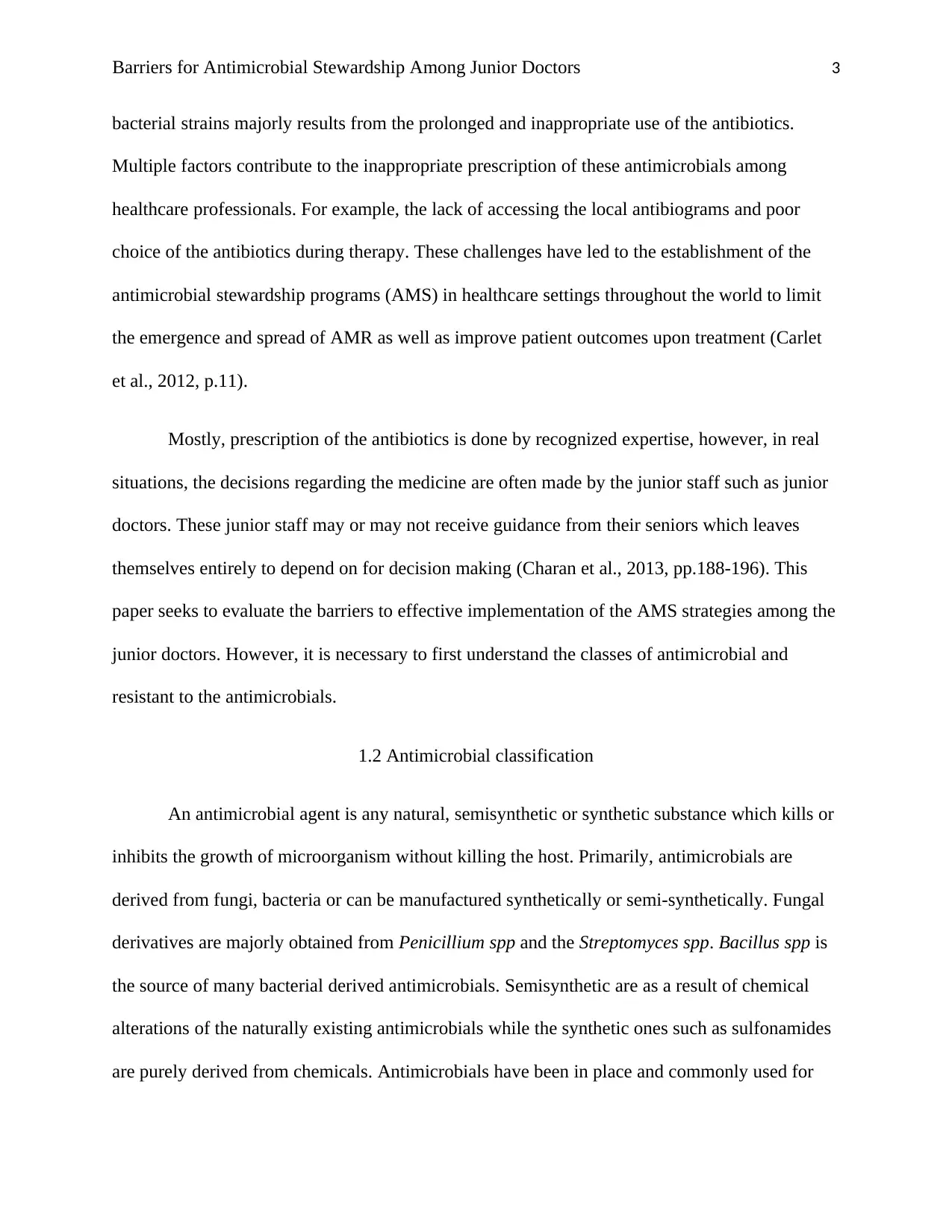
Barriers for Antimicrobial Stewardship Among Junior Doctors 3
bacterial strains majorly results from the prolonged and inappropriate use of the antibiotics.
Multiple factors contribute to the inappropriate prescription of these antimicrobials among
healthcare professionals. For example, the lack of accessing the local antibiograms and poor
choice of the antibiotics during therapy. These challenges have led to the establishment of the
antimicrobial stewardship programs (AMS) in healthcare settings throughout the world to limit
the emergence and spread of AMR as well as improve patient outcomes upon treatment (Carlet
et al., 2012, p.11).
Mostly, prescription of the antibiotics is done by recognized expertise, however, in real
situations, the decisions regarding the medicine are often made by the junior staff such as junior
doctors. These junior staff may or may not receive guidance from their seniors which leaves
themselves entirely to depend on for decision making (Charan et al., 2013, pp.188-196). This
paper seeks to evaluate the barriers to effective implementation of the AMS strategies among the
junior doctors. However, it is necessary to first understand the classes of antimicrobial and
resistant to the antimicrobials.
1.2 Antimicrobial classification
An antimicrobial agent is any natural, semisynthetic or synthetic substance which kills or
inhibits the growth of microorganism without killing the host. Primarily, antimicrobials are
derived from fungi, bacteria or can be manufactured synthetically or semi-synthetically. Fungal
derivatives are majorly obtained from Penicillium spp and the Streptomyces spp. Bacillus spp is
the source of many bacterial derived antimicrobials. Semisynthetic are as a result of chemical
alterations of the naturally existing antimicrobials while the synthetic ones such as sulfonamides
are purely derived from chemicals. Antimicrobials have been in place and commonly used for
bacterial strains majorly results from the prolonged and inappropriate use of the antibiotics.
Multiple factors contribute to the inappropriate prescription of these antimicrobials among
healthcare professionals. For example, the lack of accessing the local antibiograms and poor
choice of the antibiotics during therapy. These challenges have led to the establishment of the
antimicrobial stewardship programs (AMS) in healthcare settings throughout the world to limit
the emergence and spread of AMR as well as improve patient outcomes upon treatment (Carlet
et al., 2012, p.11).
Mostly, prescription of the antibiotics is done by recognized expertise, however, in real
situations, the decisions regarding the medicine are often made by the junior staff such as junior
doctors. These junior staff may or may not receive guidance from their seniors which leaves
themselves entirely to depend on for decision making (Charan et al., 2013, pp.188-196). This
paper seeks to evaluate the barriers to effective implementation of the AMS strategies among the
junior doctors. However, it is necessary to first understand the classes of antimicrobial and
resistant to the antimicrobials.
1.2 Antimicrobial classification
An antimicrobial agent is any natural, semisynthetic or synthetic substance which kills or
inhibits the growth of microorganism without killing the host. Primarily, antimicrobials are
derived from fungi, bacteria or can be manufactured synthetically or semi-synthetically. Fungal
derivatives are majorly obtained from Penicillium spp and the Streptomyces spp. Bacillus spp is
the source of many bacterial derived antimicrobials. Semisynthetic are as a result of chemical
alterations of the naturally existing antimicrobials while the synthetic ones such as sulfonamides
are purely derived from chemicals. Antimicrobials have been in place and commonly used for
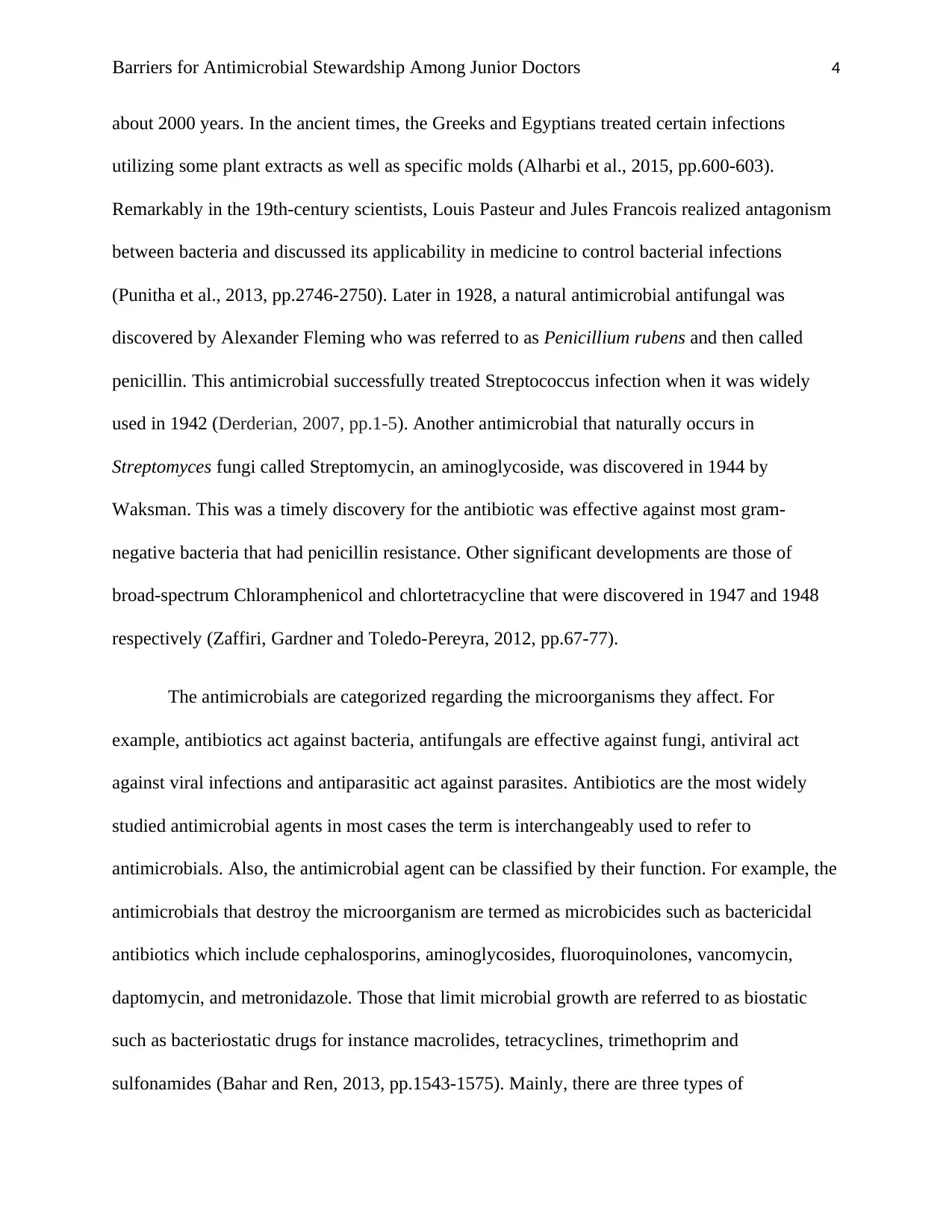
Barriers for Antimicrobial Stewardship Among Junior Doctors 4
about 2000 years. In the ancient times, the Greeks and Egyptians treated certain infections
utilizing some plant extracts as well as specific molds (Alharbi et al., 2015, pp.600-603).
Remarkably in the 19th-century scientists, Louis Pasteur and Jules Francois realized antagonism
between bacteria and discussed its applicability in medicine to control bacterial infections
(Punitha et al., 2013, pp.2746-2750). Later in 1928, a natural antimicrobial antifungal was
discovered by Alexander Fleming who was referred to as Penicillium rubens and then called
penicillin. This antimicrobial successfully treated Streptococcus infection when it was widely
used in 1942 (Derderian, 2007, pp.1-5). Another antimicrobial that naturally occurs in
Streptomyces fungi called Streptomycin, an aminoglycoside, was discovered in 1944 by
Waksman. This was a timely discovery for the antibiotic was effective against most gram-
negative bacteria that had penicillin resistance. Other significant developments are those of
broad-spectrum Chloramphenicol and chlortetracycline that were discovered in 1947 and 1948
respectively (Zaffiri, Gardner and Toledo-Pereyra, 2012, pp.67-77).
The antimicrobials are categorized regarding the microorganisms they affect. For
example, antibiotics act against bacteria, antifungals are effective against fungi, antiviral act
against viral infections and antiparasitic act against parasites. Antibiotics are the most widely
studied antimicrobial agents in most cases the term is interchangeably used to refer to
antimicrobials. Also, the antimicrobial agent can be classified by their function. For example, the
antimicrobials that destroy the microorganism are termed as microbicides such as bactericidal
antibiotics which include cephalosporins, aminoglycosides, fluoroquinolones, vancomycin,
daptomycin, and metronidazole. Those that limit microbial growth are referred to as biostatic
such as bacteriostatic drugs for instance macrolides, tetracyclines, trimethoprim and
sulfonamides (Bahar and Ren, 2013, pp.1543-1575). Mainly, there are three types of
about 2000 years. In the ancient times, the Greeks and Egyptians treated certain infections
utilizing some plant extracts as well as specific molds (Alharbi et al., 2015, pp.600-603).
Remarkably in the 19th-century scientists, Louis Pasteur and Jules Francois realized antagonism
between bacteria and discussed its applicability in medicine to control bacterial infections
(Punitha et al., 2013, pp.2746-2750). Later in 1928, a natural antimicrobial antifungal was
discovered by Alexander Fleming who was referred to as Penicillium rubens and then called
penicillin. This antimicrobial successfully treated Streptococcus infection when it was widely
used in 1942 (Derderian, 2007, pp.1-5). Another antimicrobial that naturally occurs in
Streptomyces fungi called Streptomycin, an aminoglycoside, was discovered in 1944 by
Waksman. This was a timely discovery for the antibiotic was effective against most gram-
negative bacteria that had penicillin resistance. Other significant developments are those of
broad-spectrum Chloramphenicol and chlortetracycline that were discovered in 1947 and 1948
respectively (Zaffiri, Gardner and Toledo-Pereyra, 2012, pp.67-77).
The antimicrobials are categorized regarding the microorganisms they affect. For
example, antibiotics act against bacteria, antifungals are effective against fungi, antiviral act
against viral infections and antiparasitic act against parasites. Antibiotics are the most widely
studied antimicrobial agents in most cases the term is interchangeably used to refer to
antimicrobials. Also, the antimicrobial agent can be classified by their function. For example, the
antimicrobials that destroy the microorganism are termed as microbicides such as bactericidal
antibiotics which include cephalosporins, aminoglycosides, fluoroquinolones, vancomycin,
daptomycin, and metronidazole. Those that limit microbial growth are referred to as biostatic
such as bacteriostatic drugs for instance macrolides, tetracyclines, trimethoprim and
sulfonamides (Bahar and Ren, 2013, pp.1543-1575). Mainly, there are three types of
Secure Best Marks with AI Grader
Need help grading? Try our AI Grader for instant feedback on your assignments.
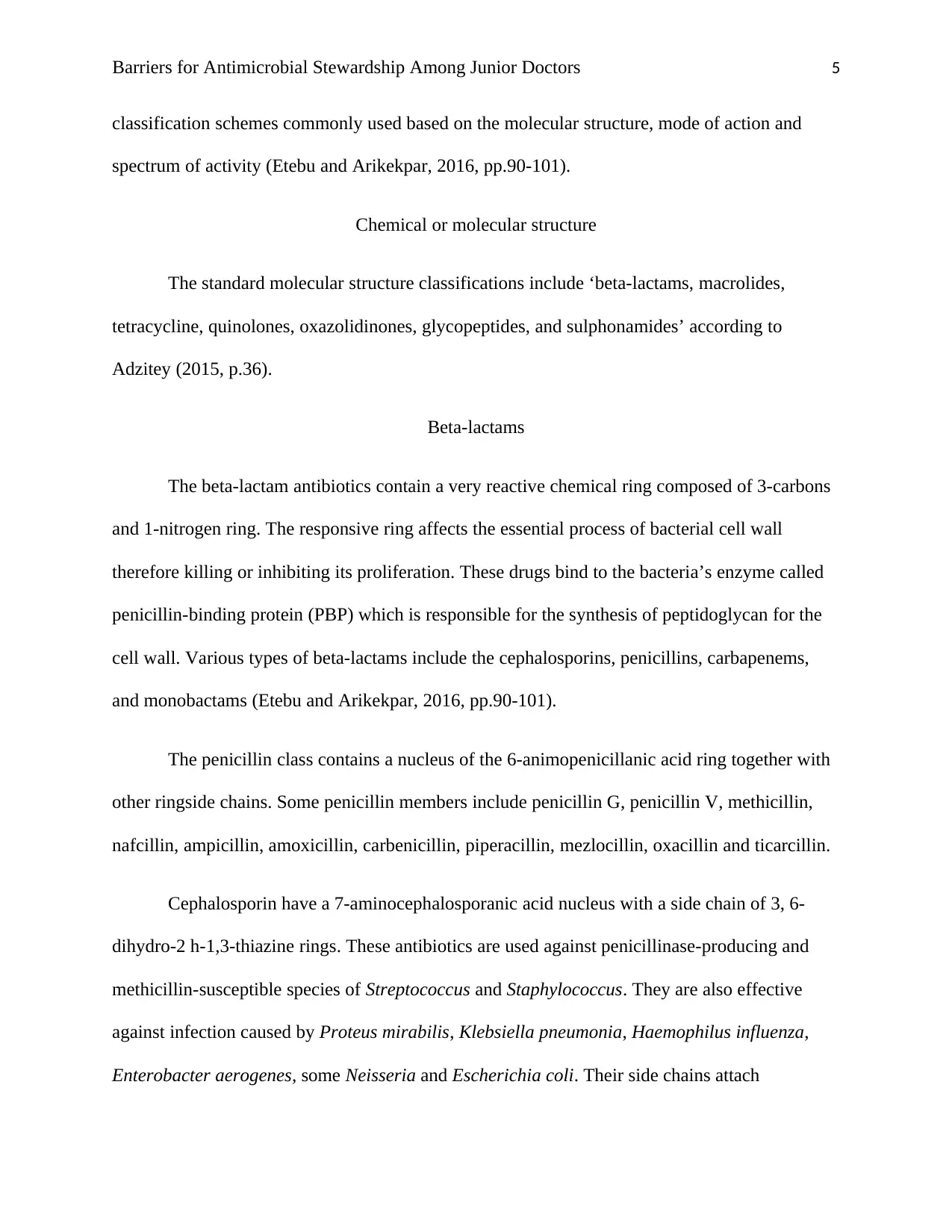
Barriers for Antimicrobial Stewardship Among Junior Doctors 5
classification schemes commonly used based on the molecular structure, mode of action and
spectrum of activity (Etebu and Arikekpar, 2016, pp.90-101).
Chemical or molecular structure
The standard molecular structure classifications include ‘beta-lactams, macrolides,
tetracycline, quinolones, oxazolidinones, glycopeptides, and sulphonamides’ according to
Adzitey (2015, p.36).
Beta-lactams
The beta-lactam antibiotics contain a very reactive chemical ring composed of 3-carbons
and 1-nitrogen ring. The responsive ring affects the essential process of bacterial cell wall
therefore killing or inhibiting its proliferation. These drugs bind to the bacteria’s enzyme called
penicillin-binding protein (PBP) which is responsible for the synthesis of peptidoglycan for the
cell wall. Various types of beta-lactams include the cephalosporins, penicillins, carbapenems,
and monobactams (Etebu and Arikekpar, 2016, pp.90-101).
The penicillin class contains a nucleus of the 6-animopenicillanic acid ring together with
other ringside chains. Some penicillin members include penicillin G, penicillin V, methicillin,
nafcillin, ampicillin, amoxicillin, carbenicillin, piperacillin, mezlocillin, oxacillin and ticarcillin.
Cephalosporin have a 7-aminocephalosporanic acid nucleus with a side chain of 3, 6-
dihydro-2 h-1,3-thiazine rings. These antibiotics are used against penicillinase-producing and
methicillin-susceptible species of Streptococcus and Staphylococcus. They are also effective
against infection caused by Proteus mirabilis, Klebsiella pneumonia, Haemophilus influenza,
Enterobacter aerogenes, some Neisseria and Escherichia coli. Their side chains attach
classification schemes commonly used based on the molecular structure, mode of action and
spectrum of activity (Etebu and Arikekpar, 2016, pp.90-101).
Chemical or molecular structure
The standard molecular structure classifications include ‘beta-lactams, macrolides,
tetracycline, quinolones, oxazolidinones, glycopeptides, and sulphonamides’ according to
Adzitey (2015, p.36).
Beta-lactams
The beta-lactam antibiotics contain a very reactive chemical ring composed of 3-carbons
and 1-nitrogen ring. The responsive ring affects the essential process of bacterial cell wall
therefore killing or inhibiting its proliferation. These drugs bind to the bacteria’s enzyme called
penicillin-binding protein (PBP) which is responsible for the synthesis of peptidoglycan for the
cell wall. Various types of beta-lactams include the cephalosporins, penicillins, carbapenems,
and monobactams (Etebu and Arikekpar, 2016, pp.90-101).
The penicillin class contains a nucleus of the 6-animopenicillanic acid ring together with
other ringside chains. Some penicillin members include penicillin G, penicillin V, methicillin,
nafcillin, ampicillin, amoxicillin, carbenicillin, piperacillin, mezlocillin, oxacillin and ticarcillin.
Cephalosporin have a 7-aminocephalosporanic acid nucleus with a side chain of 3, 6-
dihydro-2 h-1,3-thiazine rings. These antibiotics are used against penicillinase-producing and
methicillin-susceptible species of Streptococcus and Staphylococcus. They are also effective
against infection caused by Proteus mirabilis, Klebsiella pneumonia, Haemophilus influenza,
Enterobacter aerogenes, some Neisseria and Escherichia coli. Their side chains attach
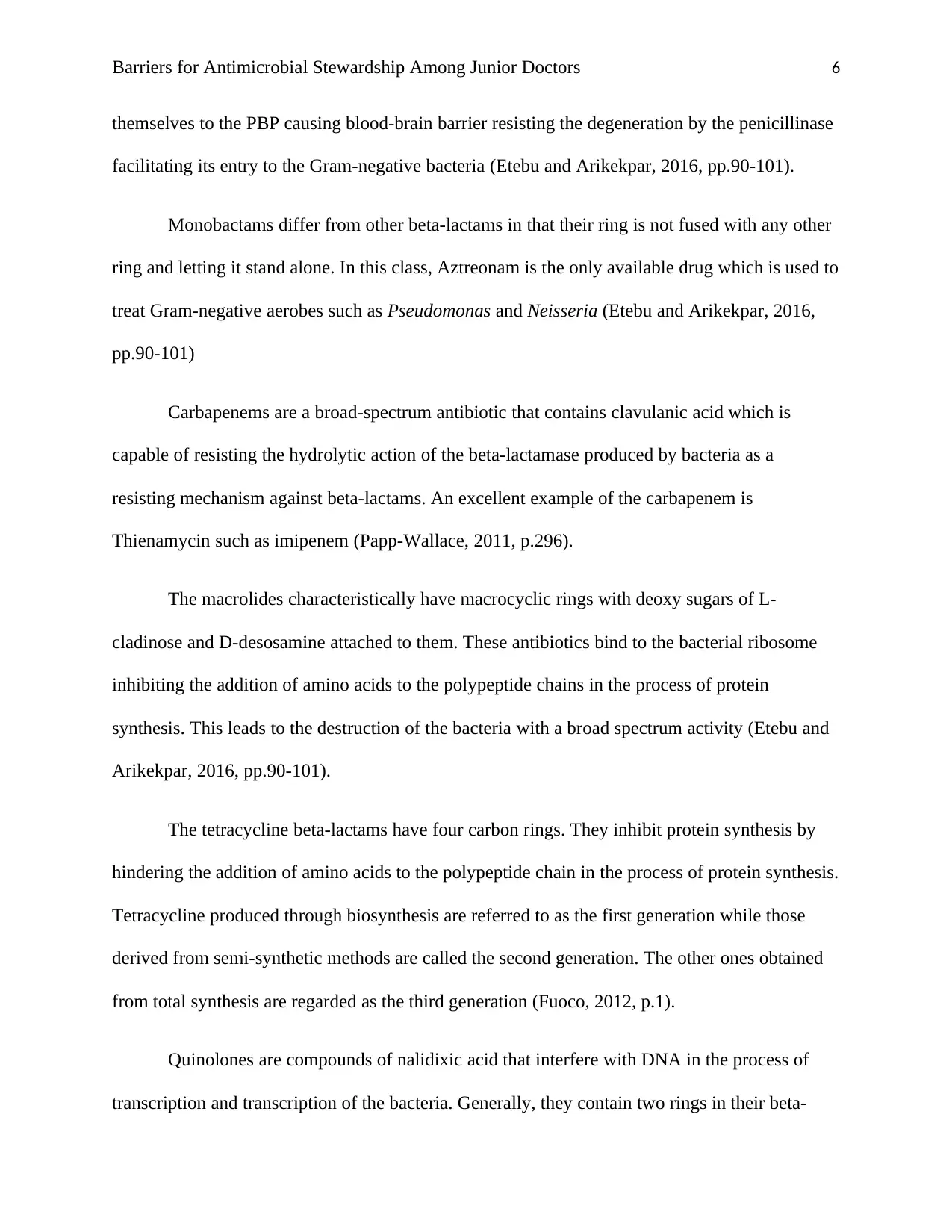
Barriers for Antimicrobial Stewardship Among Junior Doctors 6
themselves to the PBP causing blood-brain barrier resisting the degeneration by the penicillinase
facilitating its entry to the Gram-negative bacteria (Etebu and Arikekpar, 2016, pp.90-101).
Monobactams differ from other beta-lactams in that their ring is not fused with any other
ring and letting it stand alone. In this class, Aztreonam is the only available drug which is used to
treat Gram-negative aerobes such as Pseudomonas and Neisseria (Etebu and Arikekpar, 2016,
pp.90-101)
Carbapenems are a broad-spectrum antibiotic that contains clavulanic acid which is
capable of resisting the hydrolytic action of the beta-lactamase produced by bacteria as a
resisting mechanism against beta-lactams. An excellent example of the carbapenem is
Thienamycin such as imipenem (Papp-Wallace, 2011, p.296).
The macrolides characteristically have macrocyclic rings with deoxy sugars of L-
cladinose and D-desosamine attached to them. These antibiotics bind to the bacterial ribosome
inhibiting the addition of amino acids to the polypeptide chains in the process of protein
synthesis. This leads to the destruction of the bacteria with a broad spectrum activity (Etebu and
Arikekpar, 2016, pp.90-101).
The tetracycline beta-lactams have four carbon rings. They inhibit protein synthesis by
hindering the addition of amino acids to the polypeptide chain in the process of protein synthesis.
Tetracycline produced through biosynthesis are referred to as the first generation while those
derived from semi-synthetic methods are called the second generation. The other ones obtained
from total synthesis are regarded as the third generation (Fuoco, 2012, p.1).
Quinolones are compounds of nalidixic acid that interfere with DNA in the process of
transcription and transcription of the bacteria. Generally, they contain two rings in their beta-
themselves to the PBP causing blood-brain barrier resisting the degeneration by the penicillinase
facilitating its entry to the Gram-negative bacteria (Etebu and Arikekpar, 2016, pp.90-101).
Monobactams differ from other beta-lactams in that their ring is not fused with any other
ring and letting it stand alone. In this class, Aztreonam is the only available drug which is used to
treat Gram-negative aerobes such as Pseudomonas and Neisseria (Etebu and Arikekpar, 2016,
pp.90-101)
Carbapenems are a broad-spectrum antibiotic that contains clavulanic acid which is
capable of resisting the hydrolytic action of the beta-lactamase produced by bacteria as a
resisting mechanism against beta-lactams. An excellent example of the carbapenem is
Thienamycin such as imipenem (Papp-Wallace, 2011, p.296).
The macrolides characteristically have macrocyclic rings with deoxy sugars of L-
cladinose and D-desosamine attached to them. These antibiotics bind to the bacterial ribosome
inhibiting the addition of amino acids to the polypeptide chains in the process of protein
synthesis. This leads to the destruction of the bacteria with a broad spectrum activity (Etebu and
Arikekpar, 2016, pp.90-101).
The tetracycline beta-lactams have four carbon rings. They inhibit protein synthesis by
hindering the addition of amino acids to the polypeptide chain in the process of protein synthesis.
Tetracycline produced through biosynthesis are referred to as the first generation while those
derived from semi-synthetic methods are called the second generation. The other ones obtained
from total synthesis are regarded as the third generation (Fuoco, 2012, p.1).
Quinolones are compounds of nalidixic acid that interfere with DNA in the process of
transcription and transcription of the bacteria. Generally, they contain two rings in their beta-
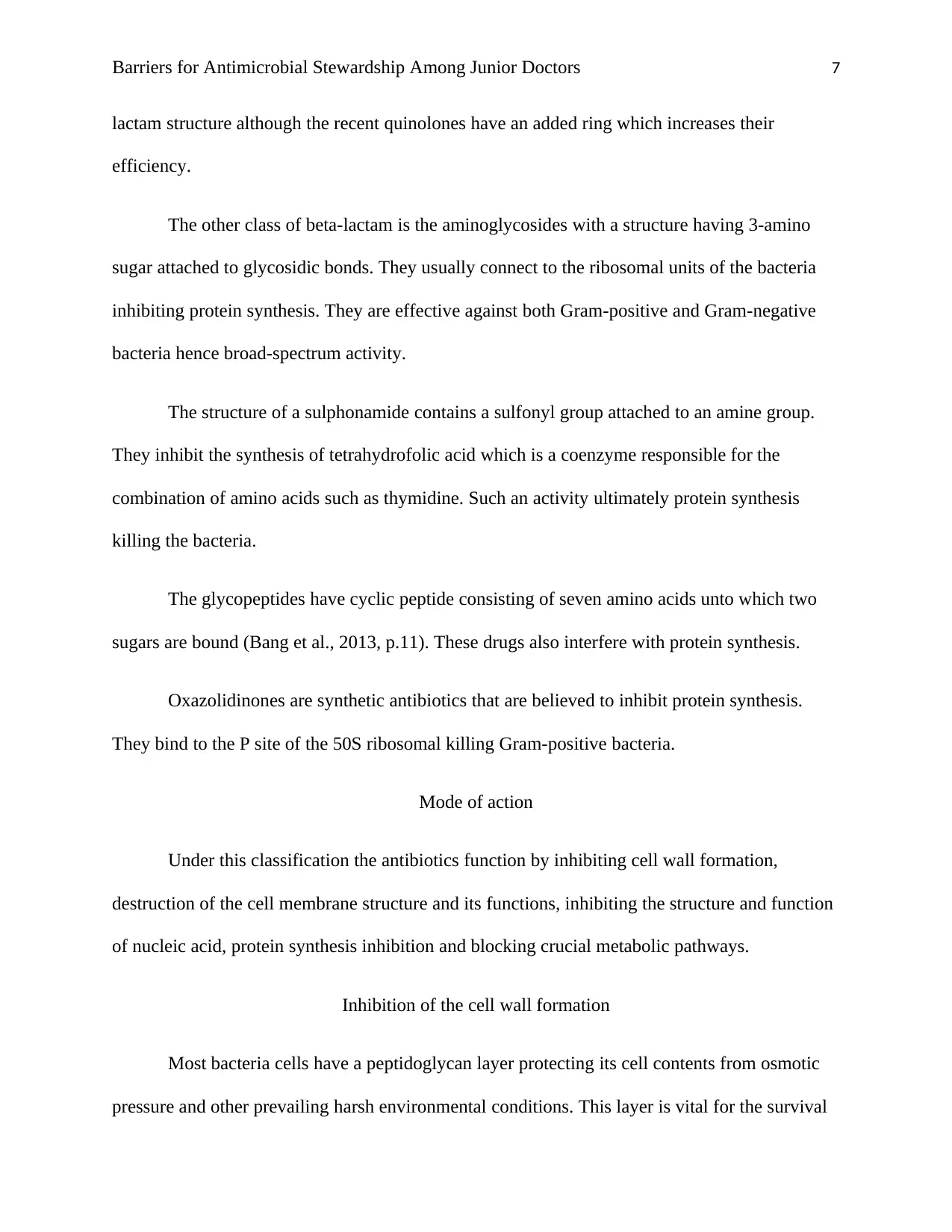
Barriers for Antimicrobial Stewardship Among Junior Doctors 7
lactam structure although the recent quinolones have an added ring which increases their
efficiency.
The other class of beta-lactam is the aminoglycosides with a structure having 3-amino
sugar attached to glycosidic bonds. They usually connect to the ribosomal units of the bacteria
inhibiting protein synthesis. They are effective against both Gram-positive and Gram-negative
bacteria hence broad-spectrum activity.
The structure of a sulphonamide contains a sulfonyl group attached to an amine group.
They inhibit the synthesis of tetrahydrofolic acid which is a coenzyme responsible for the
combination of amino acids such as thymidine. Such an activity ultimately protein synthesis
killing the bacteria.
The glycopeptides have cyclic peptide consisting of seven amino acids unto which two
sugars are bound (Bang et al., 2013, p.11). These drugs also interfere with protein synthesis.
Oxazolidinones are synthetic antibiotics that are believed to inhibit protein synthesis.
They bind to the P site of the 50S ribosomal killing Gram-positive bacteria.
Mode of action
Under this classification the antibiotics function by inhibiting cell wall formation,
destruction of the cell membrane structure and its functions, inhibiting the structure and function
of nucleic acid, protein synthesis inhibition and blocking crucial metabolic pathways.
Inhibition of the cell wall formation
Most bacteria cells have a peptidoglycan layer protecting its cell contents from osmotic
pressure and other prevailing harsh environmental conditions. This layer is vital for the survival
lactam structure although the recent quinolones have an added ring which increases their
efficiency.
The other class of beta-lactam is the aminoglycosides with a structure having 3-amino
sugar attached to glycosidic bonds. They usually connect to the ribosomal units of the bacteria
inhibiting protein synthesis. They are effective against both Gram-positive and Gram-negative
bacteria hence broad-spectrum activity.
The structure of a sulphonamide contains a sulfonyl group attached to an amine group.
They inhibit the synthesis of tetrahydrofolic acid which is a coenzyme responsible for the
combination of amino acids such as thymidine. Such an activity ultimately protein synthesis
killing the bacteria.
The glycopeptides have cyclic peptide consisting of seven amino acids unto which two
sugars are bound (Bang et al., 2013, p.11). These drugs also interfere with protein synthesis.
Oxazolidinones are synthetic antibiotics that are believed to inhibit protein synthesis.
They bind to the P site of the 50S ribosomal killing Gram-positive bacteria.
Mode of action
Under this classification the antibiotics function by inhibiting cell wall formation,
destruction of the cell membrane structure and its functions, inhibiting the structure and function
of nucleic acid, protein synthesis inhibition and blocking crucial metabolic pathways.
Inhibition of the cell wall formation
Most bacteria cells have a peptidoglycan layer protecting its cell contents from osmotic
pressure and other prevailing harsh environmental conditions. This layer is vital for the survival
Paraphrase This Document
Need a fresh take? Get an instant paraphrase of this document with our AI Paraphraser
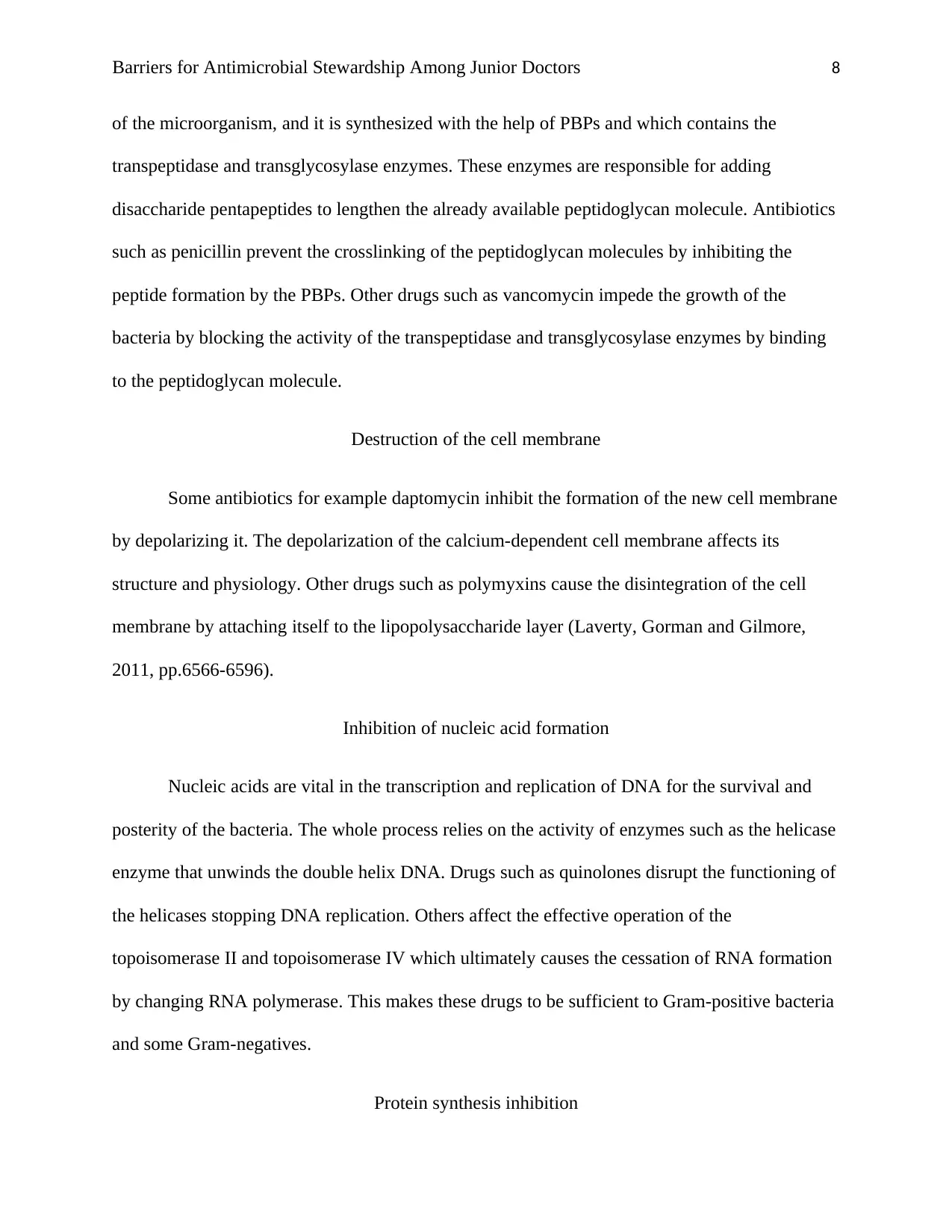
Barriers for Antimicrobial Stewardship Among Junior Doctors 8
of the microorganism, and it is synthesized with the help of PBPs and which contains the
transpeptidase and transglycosylase enzymes. These enzymes are responsible for adding
disaccharide pentapeptides to lengthen the already available peptidoglycan molecule. Antibiotics
such as penicillin prevent the crosslinking of the peptidoglycan molecules by inhibiting the
peptide formation by the PBPs. Other drugs such as vancomycin impede the growth of the
bacteria by blocking the activity of the transpeptidase and transglycosylase enzymes by binding
to the peptidoglycan molecule.
Destruction of the cell membrane
Some antibiotics for example daptomycin inhibit the formation of the new cell membrane
by depolarizing it. The depolarization of the calcium-dependent cell membrane affects its
structure and physiology. Other drugs such as polymyxins cause the disintegration of the cell
membrane by attaching itself to the lipopolysaccharide layer (Laverty, Gorman and Gilmore,
2011, pp.6566-6596).
Inhibition of nucleic acid formation
Nucleic acids are vital in the transcription and replication of DNA for the survival and
posterity of the bacteria. The whole process relies on the activity of enzymes such as the helicase
enzyme that unwinds the double helix DNA. Drugs such as quinolones disrupt the functioning of
the helicases stopping DNA replication. Others affect the effective operation of the
topoisomerase II and topoisomerase IV which ultimately causes the cessation of RNA formation
by changing RNA polymerase. This makes these drugs to be sufficient to Gram-positive bacteria
and some Gram-negatives.
Protein synthesis inhibition
of the microorganism, and it is synthesized with the help of PBPs and which contains the
transpeptidase and transglycosylase enzymes. These enzymes are responsible for adding
disaccharide pentapeptides to lengthen the already available peptidoglycan molecule. Antibiotics
such as penicillin prevent the crosslinking of the peptidoglycan molecules by inhibiting the
peptide formation by the PBPs. Other drugs such as vancomycin impede the growth of the
bacteria by blocking the activity of the transpeptidase and transglycosylase enzymes by binding
to the peptidoglycan molecule.
Destruction of the cell membrane
Some antibiotics for example daptomycin inhibit the formation of the new cell membrane
by depolarizing it. The depolarization of the calcium-dependent cell membrane affects its
structure and physiology. Other drugs such as polymyxins cause the disintegration of the cell
membrane by attaching itself to the lipopolysaccharide layer (Laverty, Gorman and Gilmore,
2011, pp.6566-6596).
Inhibition of nucleic acid formation
Nucleic acids are vital in the transcription and replication of DNA for the survival and
posterity of the bacteria. The whole process relies on the activity of enzymes such as the helicase
enzyme that unwinds the double helix DNA. Drugs such as quinolones disrupt the functioning of
the helicases stopping DNA replication. Others affect the effective operation of the
topoisomerase II and topoisomerase IV which ultimately causes the cessation of RNA formation
by changing RNA polymerase. This makes these drugs to be sufficient to Gram-positive bacteria
and some Gram-negatives.
Protein synthesis inhibition
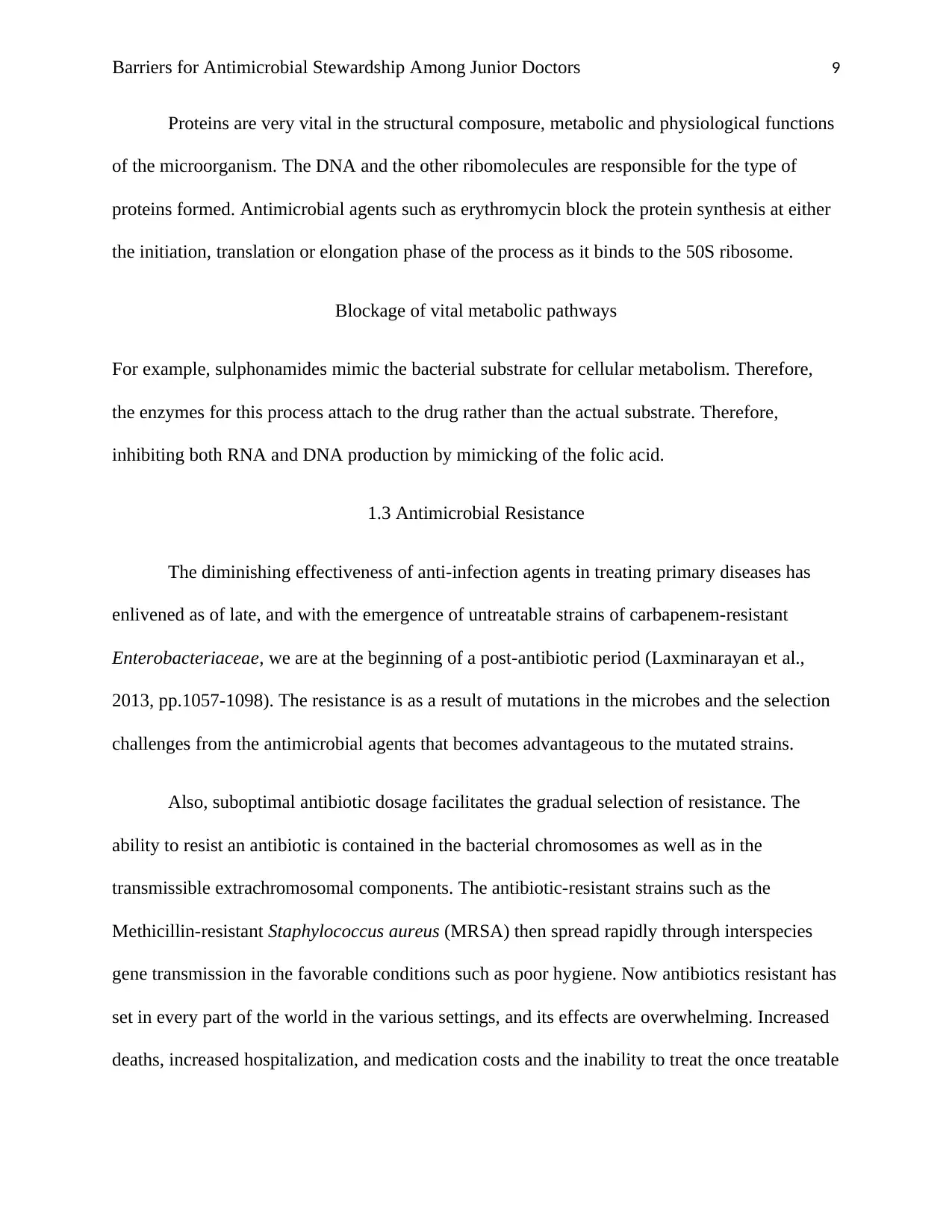
Barriers for Antimicrobial Stewardship Among Junior Doctors 9
Proteins are very vital in the structural composure, metabolic and physiological functions
of the microorganism. The DNA and the other ribomolecules are responsible for the type of
proteins formed. Antimicrobial agents such as erythromycin block the protein synthesis at either
the initiation, translation or elongation phase of the process as it binds to the 50S ribosome.
Blockage of vital metabolic pathways
For example, sulphonamides mimic the bacterial substrate for cellular metabolism. Therefore,
the enzymes for this process attach to the drug rather than the actual substrate. Therefore,
inhibiting both RNA and DNA production by mimicking of the folic acid.
1.3 Antimicrobial Resistance
The diminishing effectiveness of anti-infection agents in treating primary diseases has
enlivened as of late, and with the emergence of untreatable strains of carbapenem-resistant
Enterobacteriaceae, we are at the beginning of a post-antibiotic period (Laxminarayan et al.,
2013, pp.1057-1098). The resistance is as a result of mutations in the microbes and the selection
challenges from the antimicrobial agents that becomes advantageous to the mutated strains.
Also, suboptimal antibiotic dosage facilitates the gradual selection of resistance. The
ability to resist an antibiotic is contained in the bacterial chromosomes as well as in the
transmissible extrachromosomal components. The antibiotic-resistant strains such as the
Methicillin-resistant Staphylococcus aureus (MRSA) then spread rapidly through interspecies
gene transmission in the favorable conditions such as poor hygiene. Now antibiotics resistant has
set in every part of the world in the various settings, and its effects are overwhelming. Increased
deaths, increased hospitalization, and medication costs and the inability to treat the once treatable
Proteins are very vital in the structural composure, metabolic and physiological functions
of the microorganism. The DNA and the other ribomolecules are responsible for the type of
proteins formed. Antimicrobial agents such as erythromycin block the protein synthesis at either
the initiation, translation or elongation phase of the process as it binds to the 50S ribosome.
Blockage of vital metabolic pathways
For example, sulphonamides mimic the bacterial substrate for cellular metabolism. Therefore,
the enzymes for this process attach to the drug rather than the actual substrate. Therefore,
inhibiting both RNA and DNA production by mimicking of the folic acid.
1.3 Antimicrobial Resistance
The diminishing effectiveness of anti-infection agents in treating primary diseases has
enlivened as of late, and with the emergence of untreatable strains of carbapenem-resistant
Enterobacteriaceae, we are at the beginning of a post-antibiotic period (Laxminarayan et al.,
2013, pp.1057-1098). The resistance is as a result of mutations in the microbes and the selection
challenges from the antimicrobial agents that becomes advantageous to the mutated strains.
Also, suboptimal antibiotic dosage facilitates the gradual selection of resistance. The
ability to resist an antibiotic is contained in the bacterial chromosomes as well as in the
transmissible extrachromosomal components. The antibiotic-resistant strains such as the
Methicillin-resistant Staphylococcus aureus (MRSA) then spread rapidly through interspecies
gene transmission in the favorable conditions such as poor hygiene. Now antibiotics resistant has
set in every part of the world in the various settings, and its effects are overwhelming. Increased
deaths, increased hospitalization, and medication costs and the inability to treat the once treatable
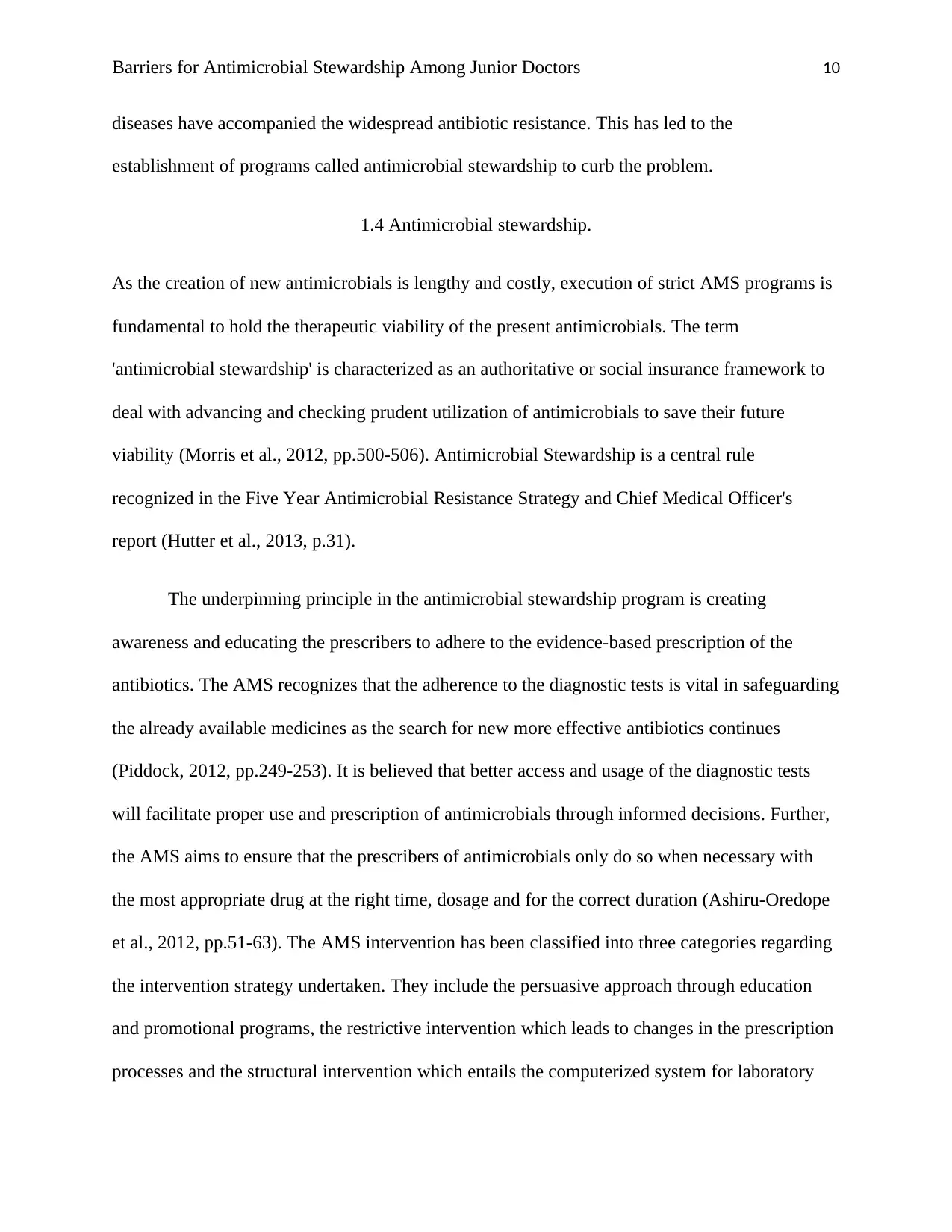
Barriers for Antimicrobial Stewardship Among Junior Doctors 10
diseases have accompanied the widespread antibiotic resistance. This has led to the
establishment of programs called antimicrobial stewardship to curb the problem.
1.4 Antimicrobial stewardship.
As the creation of new antimicrobials is lengthy and costly, execution of strict AMS programs is
fundamental to hold the therapeutic viability of the present antimicrobials. The term
'antimicrobial stewardship' is characterized as an authoritative or social insurance framework to
deal with advancing and checking prudent utilization of antimicrobials to save their future
viability (Morris et al., 2012, pp.500-506). Antimicrobial Stewardship is a central rule
recognized in the Five Year Antimicrobial Resistance Strategy and Chief Medical Officer's
report (Hutter et al., 2013, p.31).
The underpinning principle in the antimicrobial stewardship program is creating
awareness and educating the prescribers to adhere to the evidence-based prescription of the
antibiotics. The AMS recognizes that the adherence to the diagnostic tests is vital in safeguarding
the already available medicines as the search for new more effective antibiotics continues
(Piddock, 2012, pp.249-253). It is believed that better access and usage of the diagnostic tests
will facilitate proper use and prescription of antimicrobials through informed decisions. Further,
the AMS aims to ensure that the prescribers of antimicrobials only do so when necessary with
the most appropriate drug at the right time, dosage and for the correct duration (Ashiru-Oredope
et al., 2012, pp.51-63). The AMS intervention has been classified into three categories regarding
the intervention strategy undertaken. They include the persuasive approach through education
and promotional programs, the restrictive intervention which leads to changes in the prescription
processes and the structural intervention which entails the computerized system for laboratory
diseases have accompanied the widespread antibiotic resistance. This has led to the
establishment of programs called antimicrobial stewardship to curb the problem.
1.4 Antimicrobial stewardship.
As the creation of new antimicrobials is lengthy and costly, execution of strict AMS programs is
fundamental to hold the therapeutic viability of the present antimicrobials. The term
'antimicrobial stewardship' is characterized as an authoritative or social insurance framework to
deal with advancing and checking prudent utilization of antimicrobials to save their future
viability (Morris et al., 2012, pp.500-506). Antimicrobial Stewardship is a central rule
recognized in the Five Year Antimicrobial Resistance Strategy and Chief Medical Officer's
report (Hutter et al., 2013, p.31).
The underpinning principle in the antimicrobial stewardship program is creating
awareness and educating the prescribers to adhere to the evidence-based prescription of the
antibiotics. The AMS recognizes that the adherence to the diagnostic tests is vital in safeguarding
the already available medicines as the search for new more effective antibiotics continues
(Piddock, 2012, pp.249-253). It is believed that better access and usage of the diagnostic tests
will facilitate proper use and prescription of antimicrobials through informed decisions. Further,
the AMS aims to ensure that the prescribers of antimicrobials only do so when necessary with
the most appropriate drug at the right time, dosage and for the correct duration (Ashiru-Oredope
et al., 2012, pp.51-63). The AMS intervention has been classified into three categories regarding
the intervention strategy undertaken. They include the persuasive approach through education
and promotional programs, the restrictive intervention which leads to changes in the prescription
processes and the structural intervention which entails the computerized system for laboratory
Secure Best Marks with AI Grader
Need help grading? Try our AI Grader for instant feedback on your assignments.
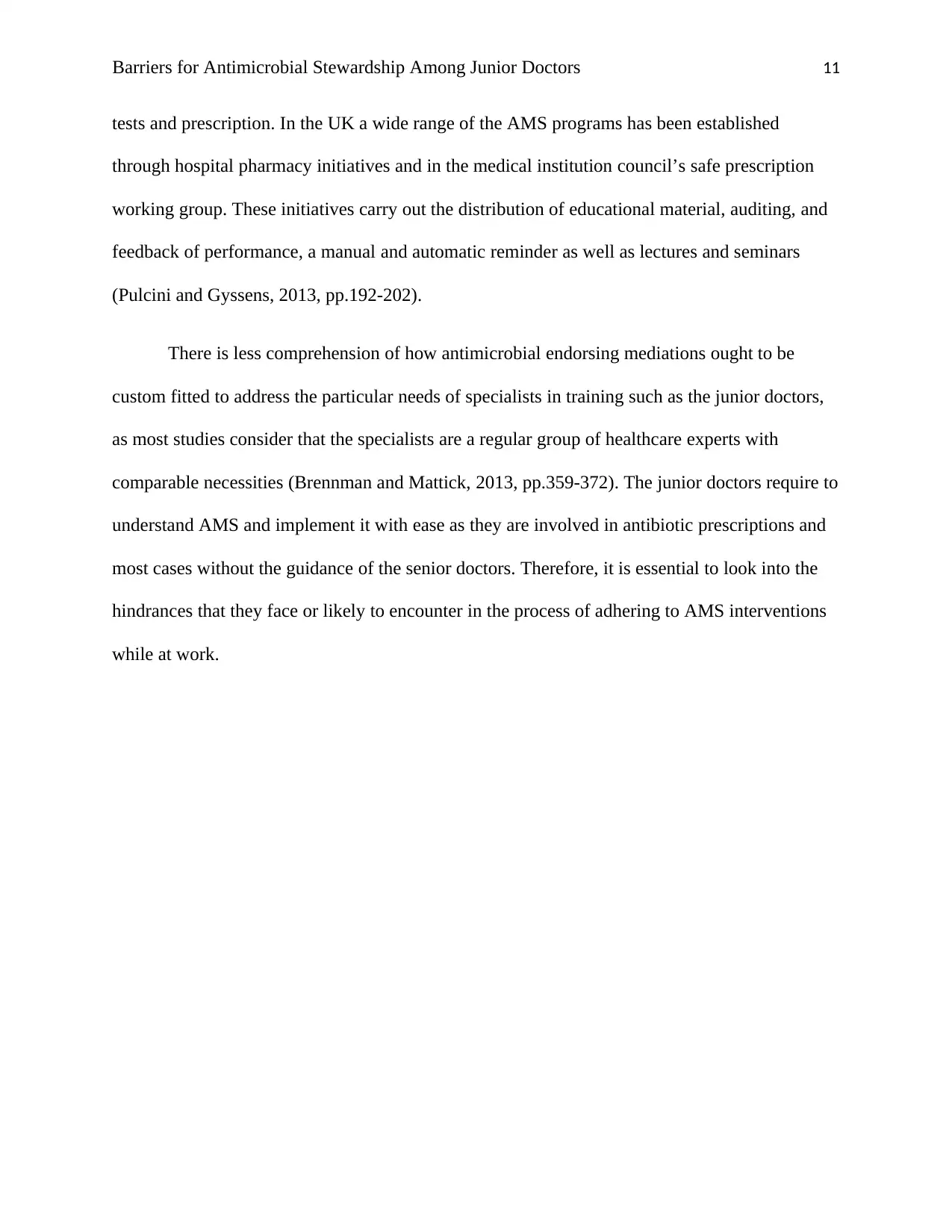
Barriers for Antimicrobial Stewardship Among Junior Doctors 11
tests and prescription. In the UK a wide range of the AMS programs has been established
through hospital pharmacy initiatives and in the medical institution council’s safe prescription
working group. These initiatives carry out the distribution of educational material, auditing, and
feedback of performance, a manual and automatic reminder as well as lectures and seminars
(Pulcini and Gyssens, 2013, pp.192-202).
There is less comprehension of how antimicrobial endorsing mediations ought to be
custom fitted to address the particular needs of specialists in training such as the junior doctors,
as most studies consider that the specialists are a regular group of healthcare experts with
comparable necessities (Brennman and Mattick, 2013, pp.359-372). The junior doctors require to
understand AMS and implement it with ease as they are involved in antibiotic prescriptions and
most cases without the guidance of the senior doctors. Therefore, it is essential to look into the
hindrances that they face or likely to encounter in the process of adhering to AMS interventions
while at work.
tests and prescription. In the UK a wide range of the AMS programs has been established
through hospital pharmacy initiatives and in the medical institution council’s safe prescription
working group. These initiatives carry out the distribution of educational material, auditing, and
feedback of performance, a manual and automatic reminder as well as lectures and seminars
(Pulcini and Gyssens, 2013, pp.192-202).
There is less comprehension of how antimicrobial endorsing mediations ought to be
custom fitted to address the particular needs of specialists in training such as the junior doctors,
as most studies consider that the specialists are a regular group of healthcare experts with
comparable necessities (Brennman and Mattick, 2013, pp.359-372). The junior doctors require to
understand AMS and implement it with ease as they are involved in antibiotic prescriptions and
most cases without the guidance of the senior doctors. Therefore, it is essential to look into the
hindrances that they face or likely to encounter in the process of adhering to AMS interventions
while at work.

Barriers for Antimicrobial Stewardship Among Junior Doctors 12
References
Adzitey, F., 2015. Antibiotic classes and antibiotic susceptibility of bacterial isolates from
selected poultry; a mini review. World s Veterinary Journal, vol. 6, no. 1, 2015, p. 36.
Alharbi, N.S., Alharbi, S.A., Salmen, S.H., Chinnathambi, A., Al-Johny, B.O. and Wainwright,
M., 2015. 2 Mycelium of Fungi Isolated from Mouldy Foods Inhibits Staphylococcus aureus
including MRSA-A Rationale for the Re-introduction of Mycotherapy?. Saudi Journal of
Biological Sciences, vol. 22, no. 5, 2015, pp. 600-603.
Ashiru-Oredope, D., Sharland, M., Charani, E., McNulty, C. and Cooke, J., 2012. Improving the
quality of antibiotic prescribing in the NHS by developing a new Antimicrobial Stewardship
Programme: Start Smart—Then Focus. Journal of antimicrobial chemotherapy, vol. 67
(suppl_1), pp.i51-i63.
Bahar, A. and Ren, D., 2013. Antimicrobial peptides. Pharmaceuticals, vol. 6, no. 12, pp.1543-
1575.
Bang, J.K., Lee, J.H., Murugan, R.N., Lee, S.G., Do, H., Koh, H.Y., Shim, H.E., Kim, H.C. and
Kim, H.J., 2013. Antifreeze peptides and glycopeptides, and their derivatives: potential uses in
biotechnology. Marine drugs, vol. 11, no. 6, pp. 2013-2041.
Brennan, N. and Mattick, K., 2013. A systematic review of educational interventions to change
behaviour of prescribers in hospital settings, with a particular emphasis on new
prescribers. British journal of clinical pharmacology, vol. 75, no. 2, pp. 359-372.
References
Adzitey, F., 2015. Antibiotic classes and antibiotic susceptibility of bacterial isolates from
selected poultry; a mini review. World s Veterinary Journal, vol. 6, no. 1, 2015, p. 36.
Alharbi, N.S., Alharbi, S.A., Salmen, S.H., Chinnathambi, A., Al-Johny, B.O. and Wainwright,
M., 2015. 2 Mycelium of Fungi Isolated from Mouldy Foods Inhibits Staphylococcus aureus
including MRSA-A Rationale for the Re-introduction of Mycotherapy?. Saudi Journal of
Biological Sciences, vol. 22, no. 5, 2015, pp. 600-603.
Ashiru-Oredope, D., Sharland, M., Charani, E., McNulty, C. and Cooke, J., 2012. Improving the
quality of antibiotic prescribing in the NHS by developing a new Antimicrobial Stewardship
Programme: Start Smart—Then Focus. Journal of antimicrobial chemotherapy, vol. 67
(suppl_1), pp.i51-i63.
Bahar, A. and Ren, D., 2013. Antimicrobial peptides. Pharmaceuticals, vol. 6, no. 12, pp.1543-
1575.
Bang, J.K., Lee, J.H., Murugan, R.N., Lee, S.G., Do, H., Koh, H.Y., Shim, H.E., Kim, H.C. and
Kim, H.J., 2013. Antifreeze peptides and glycopeptides, and their derivatives: potential uses in
biotechnology. Marine drugs, vol. 11, no. 6, pp. 2013-2041.
Brennan, N. and Mattick, K., 2013. A systematic review of educational interventions to change
behaviour of prescribers in hospital settings, with a particular emphasis on new
prescribers. British journal of clinical pharmacology, vol. 75, no. 2, pp. 359-372.
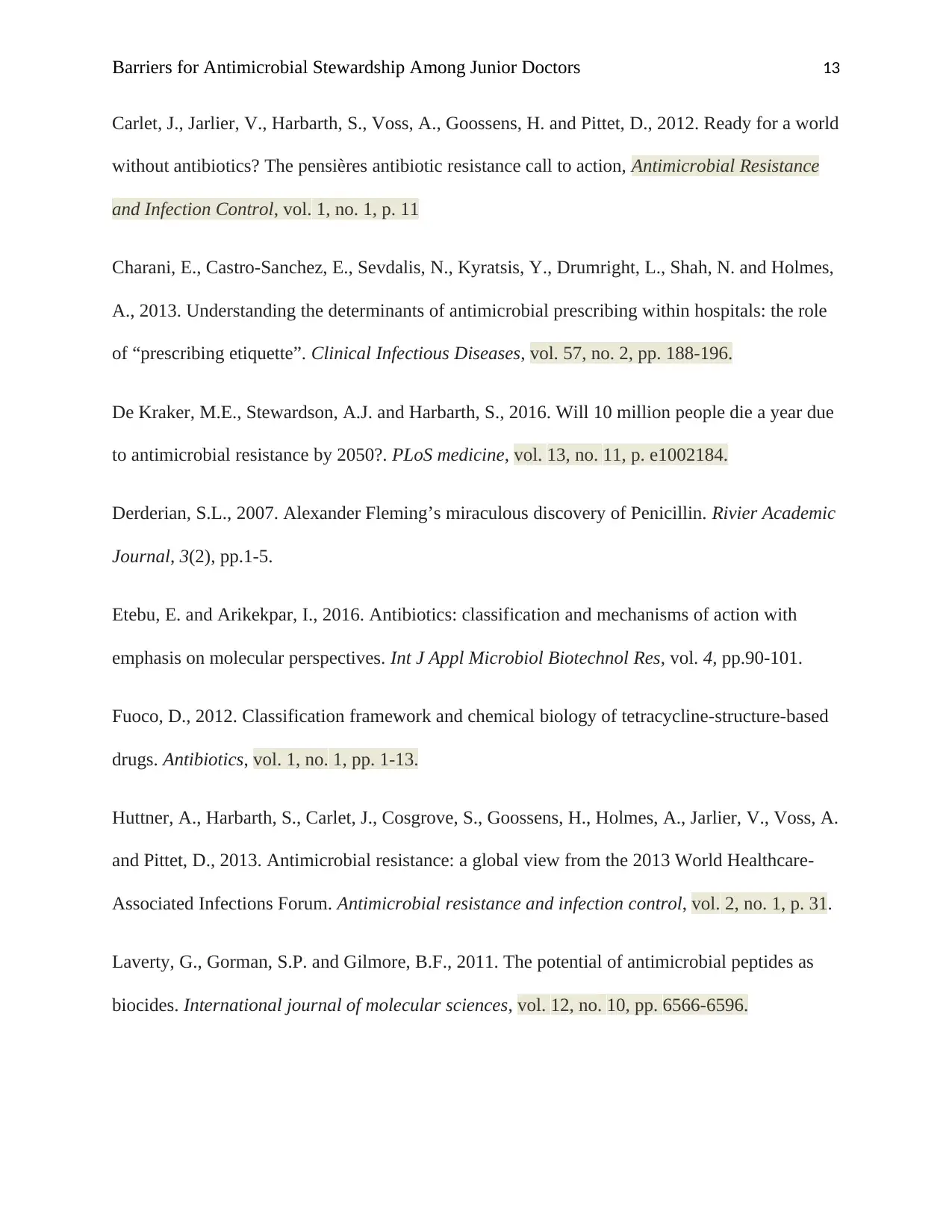
Barriers for Antimicrobial Stewardship Among Junior Doctors 13
Carlet, J., Jarlier, V., Harbarth, S., Voss, A., Goossens, H. and Pittet, D., 2012. Ready for a world
without antibiotics? The pensières antibiotic resistance call to action, Antimicrobial Resistance
and Infection Control, vol. 1, no. 1, p. 11
Charani, E., Castro-Sanchez, E., Sevdalis, N., Kyratsis, Y., Drumright, L., Shah, N. and Holmes,
A., 2013. Understanding the determinants of antimicrobial prescribing within hospitals: the role
of “prescribing etiquette”. Clinical Infectious Diseases, vol. 57, no. 2, pp. 188-196.
De Kraker, M.E., Stewardson, A.J. and Harbarth, S., 2016. Will 10 million people die a year due
to antimicrobial resistance by 2050?. PLoS medicine, vol. 13, no. 11, p. e1002184.
Derderian, S.L., 2007. Alexander Fleming’s miraculous discovery of Penicillin. Rivier Academic
Journal, 3(2), pp.1-5.
Etebu, E. and Arikekpar, I., 2016. Antibiotics: classification and mechanisms of action with
emphasis on molecular perspectives. Int J Appl Microbiol Biotechnol Res, vol. 4, pp.90-101.
Fuoco, D., 2012. Classification framework and chemical biology of tetracycline-structure-based
drugs. Antibiotics, vol. 1, no. 1, pp. 1-13.
Huttner, A., Harbarth, S., Carlet, J., Cosgrove, S., Goossens, H., Holmes, A., Jarlier, V., Voss, A.
and Pittet, D., 2013. Antimicrobial resistance: a global view from the 2013 World Healthcare-
Associated Infections Forum. Antimicrobial resistance and infection control, vol. 2, no. 1, p. 31.
Laverty, G., Gorman, S.P. and Gilmore, B.F., 2011. The potential of antimicrobial peptides as
biocides. International journal of molecular sciences, vol. 12, no. 10, pp. 6566-6596.
Carlet, J., Jarlier, V., Harbarth, S., Voss, A., Goossens, H. and Pittet, D., 2012. Ready for a world
without antibiotics? The pensières antibiotic resistance call to action, Antimicrobial Resistance
and Infection Control, vol. 1, no. 1, p. 11
Charani, E., Castro-Sanchez, E., Sevdalis, N., Kyratsis, Y., Drumright, L., Shah, N. and Holmes,
A., 2013. Understanding the determinants of antimicrobial prescribing within hospitals: the role
of “prescribing etiquette”. Clinical Infectious Diseases, vol. 57, no. 2, pp. 188-196.
De Kraker, M.E., Stewardson, A.J. and Harbarth, S., 2016. Will 10 million people die a year due
to antimicrobial resistance by 2050?. PLoS medicine, vol. 13, no. 11, p. e1002184.
Derderian, S.L., 2007. Alexander Fleming’s miraculous discovery of Penicillin. Rivier Academic
Journal, 3(2), pp.1-5.
Etebu, E. and Arikekpar, I., 2016. Antibiotics: classification and mechanisms of action with
emphasis on molecular perspectives. Int J Appl Microbiol Biotechnol Res, vol. 4, pp.90-101.
Fuoco, D., 2012. Classification framework and chemical biology of tetracycline-structure-based
drugs. Antibiotics, vol. 1, no. 1, pp. 1-13.
Huttner, A., Harbarth, S., Carlet, J., Cosgrove, S., Goossens, H., Holmes, A., Jarlier, V., Voss, A.
and Pittet, D., 2013. Antimicrobial resistance: a global view from the 2013 World Healthcare-
Associated Infections Forum. Antimicrobial resistance and infection control, vol. 2, no. 1, p. 31.
Laverty, G., Gorman, S.P. and Gilmore, B.F., 2011. The potential of antimicrobial peptides as
biocides. International journal of molecular sciences, vol. 12, no. 10, pp. 6566-6596.
Paraphrase This Document
Need a fresh take? Get an instant paraphrase of this document with our AI Paraphraser
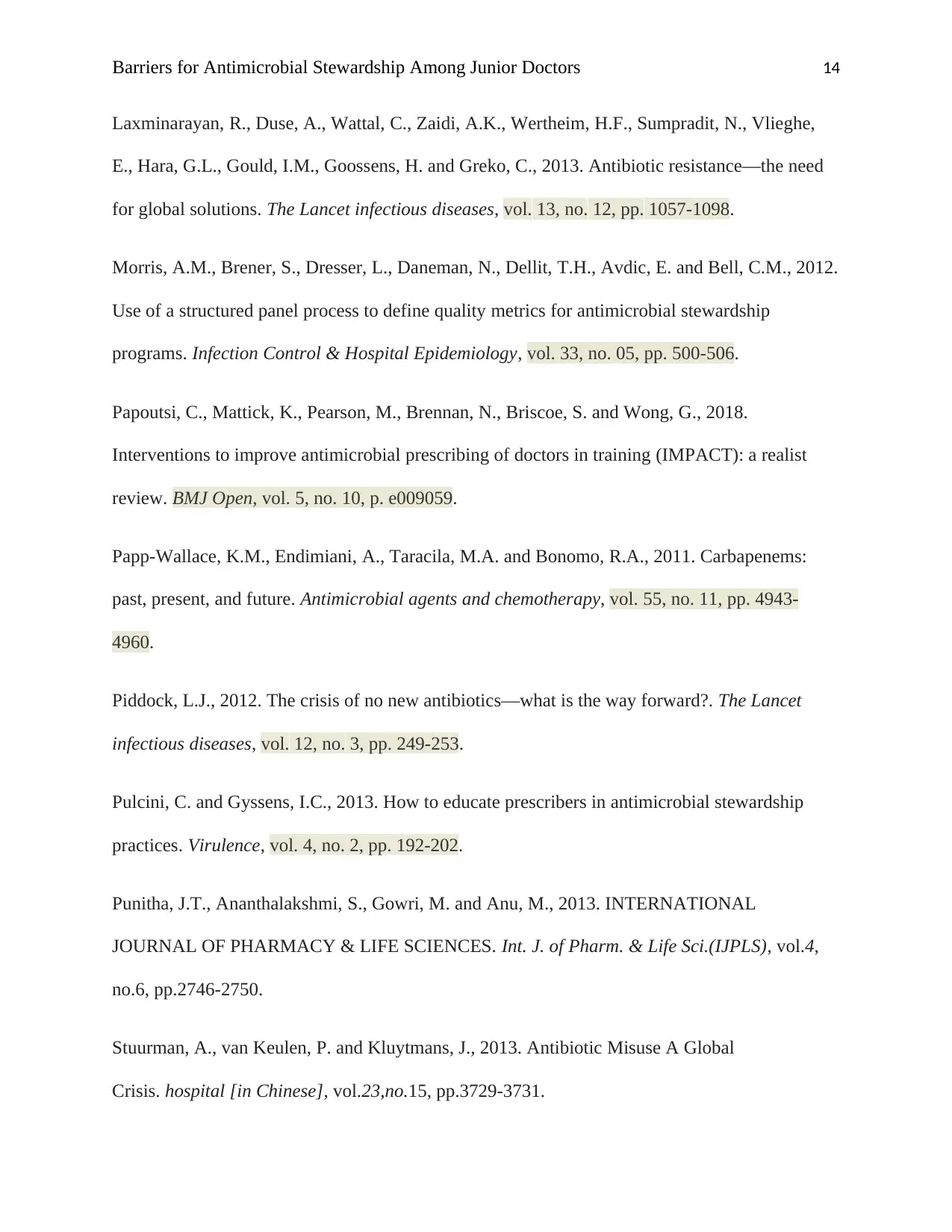
Barriers for Antimicrobial Stewardship Among Junior Doctors 14
Laxminarayan, R., Duse, A., Wattal, C., Zaidi, A.K., Wertheim, H.F., Sumpradit, N., Vlieghe,
E., Hara, G.L., Gould, I.M., Goossens, H. and Greko, C., 2013. Antibiotic resistance—the need
for global solutions. The Lancet infectious diseases, vol. 13, no. 12, pp. 1057-1098.
Morris, A.M., Brener, S., Dresser, L., Daneman, N., Dellit, T.H., Avdic, E. and Bell, C.M., 2012.
Use of a structured panel process to define quality metrics for antimicrobial stewardship
programs. Infection Control & Hospital Epidemiology, vol. 33, no. 05, pp. 500-506.
Papoutsi, C., Mattick, K., Pearson, M., Brennan, N., Briscoe, S. and Wong, G., 2018.
Interventions to improve antimicrobial prescribing of doctors in training (IMPACT): a realist
review. BMJ Open, vol. 5, no. 10, p. e009059.
Papp-Wallace, K.M., Endimiani, A., Taracila, M.A. and Bonomo, R.A., 2011. Carbapenems:
past, present, and future. Antimicrobial agents and chemotherapy, vol. 55, no. 11, pp. 4943-
4960.
Piddock, L.J., 2012. The crisis of no new antibiotics—what is the way forward?. The Lancet
infectious diseases, vol. 12, no. 3, pp. 249-253.
Pulcini, C. and Gyssens, I.C., 2013. How to educate prescribers in antimicrobial stewardship
practices. Virulence, vol. 4, no. 2, pp. 192-202.
Punitha, J.T., Ananthalakshmi, S., Gowri, M. and Anu, M., 2013. INTERNATIONAL
JOURNAL OF PHARMACY & LIFE SCIENCES. Int. J. of Pharm. & Life Sci.(IJPLS), vol.4,
no.6, pp.2746-2750.
Stuurman, A., van Keulen, P. and Kluytmans, J., 2013. Antibiotic Misuse A Global
Crisis. hospital [in Chinese], vol.23,no.15, pp.3729-3731.
Laxminarayan, R., Duse, A., Wattal, C., Zaidi, A.K., Wertheim, H.F., Sumpradit, N., Vlieghe,
E., Hara, G.L., Gould, I.M., Goossens, H. and Greko, C., 2013. Antibiotic resistance—the need
for global solutions. The Lancet infectious diseases, vol. 13, no. 12, pp. 1057-1098.
Morris, A.M., Brener, S., Dresser, L., Daneman, N., Dellit, T.H., Avdic, E. and Bell, C.M., 2012.
Use of a structured panel process to define quality metrics for antimicrobial stewardship
programs. Infection Control & Hospital Epidemiology, vol. 33, no. 05, pp. 500-506.
Papoutsi, C., Mattick, K., Pearson, M., Brennan, N., Briscoe, S. and Wong, G., 2018.
Interventions to improve antimicrobial prescribing of doctors in training (IMPACT): a realist
review. BMJ Open, vol. 5, no. 10, p. e009059.
Papp-Wallace, K.M., Endimiani, A., Taracila, M.A. and Bonomo, R.A., 2011. Carbapenems:
past, present, and future. Antimicrobial agents and chemotherapy, vol. 55, no. 11, pp. 4943-
4960.
Piddock, L.J., 2012. The crisis of no new antibiotics—what is the way forward?. The Lancet
infectious diseases, vol. 12, no. 3, pp. 249-253.
Pulcini, C. and Gyssens, I.C., 2013. How to educate prescribers in antimicrobial stewardship
practices. Virulence, vol. 4, no. 2, pp. 192-202.
Punitha, J.T., Ananthalakshmi, S., Gowri, M. and Anu, M., 2013. INTERNATIONAL
JOURNAL OF PHARMACY & LIFE SCIENCES. Int. J. of Pharm. & Life Sci.(IJPLS), vol.4,
no.6, pp.2746-2750.
Stuurman, A., van Keulen, P. and Kluytmans, J., 2013. Antibiotic Misuse A Global
Crisis. hospital [in Chinese], vol.23,no.15, pp.3729-3731.
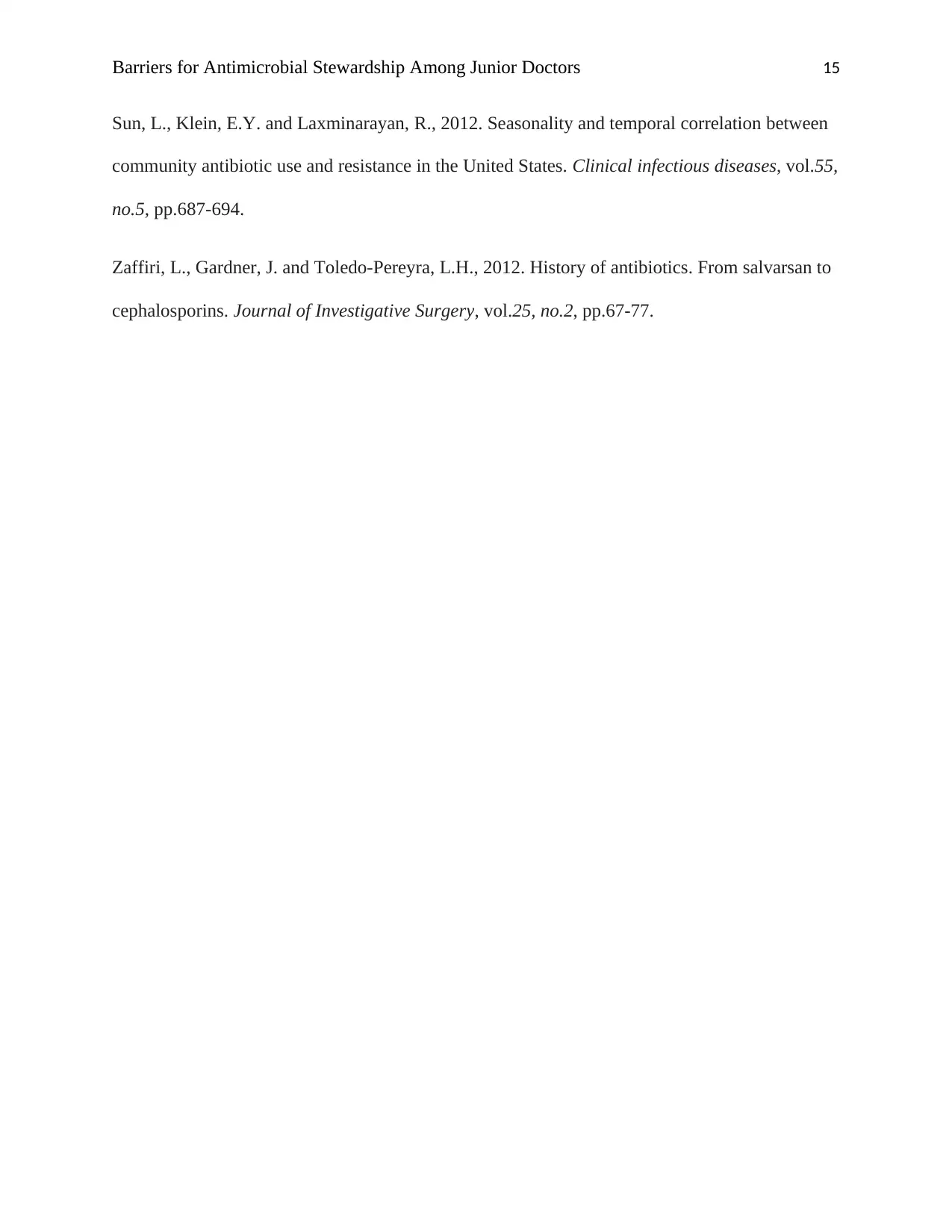
Barriers for Antimicrobial Stewardship Among Junior Doctors 15
Sun, L., Klein, E.Y. and Laxminarayan, R., 2012. Seasonality and temporal correlation between
community antibiotic use and resistance in the United States. Clinical infectious diseases, vol.55,
no.5, pp.687-694.
Zaffiri, L., Gardner, J. and Toledo-Pereyra, L.H., 2012. History of antibiotics. From salvarsan to
cephalosporins. Journal of Investigative Surgery, vol.25, no.2, pp.67-77.
Sun, L., Klein, E.Y. and Laxminarayan, R., 2012. Seasonality and temporal correlation between
community antibiotic use and resistance in the United States. Clinical infectious diseases, vol.55,
no.5, pp.687-694.
Zaffiri, L., Gardner, J. and Toledo-Pereyra, L.H., 2012. History of antibiotics. From salvarsan to
cephalosporins. Journal of Investigative Surgery, vol.25, no.2, pp.67-77.
1 out of 15
Your All-in-One AI-Powered Toolkit for Academic Success.
+13062052269
info@desklib.com
Available 24*7 on WhatsApp / Email
![[object Object]](/_next/static/media/star-bottom.7253800d.svg)
Unlock your academic potential
© 2024 | Zucol Services PVT LTD | All rights reserved.

